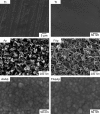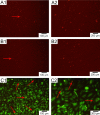Tissue-engineered endothelial cell layers on surface-modified Ti for inhibiting in vitro platelet adhesion
- PMID: 27877575
- PMCID: PMC5090506
- DOI: 10.1088/1468-6996/14/3/035002
Tissue-engineered endothelial cell layers on surface-modified Ti for inhibiting in vitro platelet adhesion
Abstract
A tissue-engineered endothelial layer was prepared by culturing endothelial cells on a fibroblast growth factor-2 (FGF-2)-l-ascorbic acid phosphate magnesium salt n-hydrate (AsMg)-apatite (Ap) coated titanium plate. The FGF-2-AsMg-Ap coated Ti plate was prepared by immersing a Ti plate in supersaturated calcium phosphate solutions supplemented with FGF-2 and AsMg. The FGF-2-AsMg-Ap layer on the Ti plate accelerated proliferation of human umbilical vein endothelial cells (HUVECs), and showed slightly higher, but not statistically significant, nitric oxide release from HUVECs than on as-prepared Ti. The endothelial layer maintained proper function of the endothelial cells and markedly inhibited in vitro platelet adhesion. The tissue-engineered endothelial layer formed on the FGF-2-AsMg-Ap layer is promising for ameliorating platelet activation and thrombus formation on cardiovascular implants.
Keywords: 10.01; 10.03; apatite; ascorbate; endothelial cell; fibroblast growth factor-2; platelet adhesion.
Figures










Similar articles
-
Ascorbate-apatite composite and ascorbate-FGF-2-apatite composite layers formed on external fixation rods and their effects on cell activity in vitro.Acta Biomater. 2009 Sep;5(7):2647-56. doi: 10.1016/j.actbio.2009.03.020. Epub 2009 Mar 27. Acta Biomater. 2009. PMID: 19375998
-
Improvement in endothelial cell adhesion and retention under physiological shear stress using a laminin-apatite composite layer on titanium.J R Soc Interface. 2013 Feb 13;10(81):20130014. doi: 10.1098/rsif.2013.0014. Print 2013 Apr 6. J R Soc Interface. 2013. PMID: 23407573 Free PMC article.
-
Reducing the risk of impaired bone apposition to titanium screws with the use of fibroblast growth factor-2-apatite composite layer coating.J Orthop Surg Res. 2017 Jan 5;12(1):1. doi: 10.1186/s13018-016-0501-z. J Orthop Surg Res. 2017. PMID: 28057033 Free PMC article.
-
Fibroblast growth factor-2-apatite composite layers on titanium screw to reduce pin tract infection rate.J Biomed Mater Res B Appl Biomater. 2008 Aug;86(2):365-74. doi: 10.1002/jbm.b.31029. J Biomed Mater Res B Appl Biomater. 2008. PMID: 18286592
-
Impacts of chemically different surfaces of implants on a biological activity of fibroblast growth factor-2-apatite composite layers formed on the implants.Orthop Traumatol Surg Res. 2021 Feb;107(1):102748. doi: 10.1016/j.otsr.2020.102748. Epub 2020 Dec 11. Orthop Traumatol Surg Res. 2021. PMID: 33316452
Cited by
-
Human amniotic epithelial cell transplantation for the repair of injured brachial plexus nerve: evaluation of nerve viscoelastic properties.Neural Regen Res. 2015 Feb;10(2):260-5. doi: 10.4103/1673-5374.152380. Neural Regen Res. 2015. PMID: 25883625 Free PMC article.
-
Biological conduits combining bone marrow mesenchymal stem cells and extracellular matrix to treat long-segment sciatic nerve defects.Neural Regen Res. 2015 Jun;10(6):965-71. doi: 10.4103/1673-5374.158362. Neural Regen Res. 2015. PMID: 26199615 Free PMC article.
References
LinkOut - more resources
Full Text Sources
Other Literature Sources
